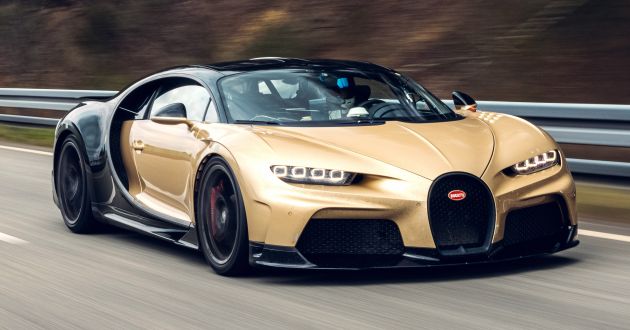Bugatti details Chiron Super Sport development work
Following the debut of the Bugatti Chiron Super Sport earlier this month, the carmaker is now giving us an insight into final development stages of the model, which will make its way to customers from the end of August this year. With a starting price of 3.2 million euros (nearly RM16 million) before options, ensuring everything is prim and proper is something the company wants to get right.
High-speed testing is a crucial aspect of the car’s development, as the model must be able to hit its top speed of 440 km/h without issues. This requires engineers to fine-tune the mechanics, damping and aerodynamics before the keys are handed over.
“Following successful road tests at up to 380 km/h, we are now refining the handling of the vehicle at up to 440 km/h to allow the Chiron Super Sport to perform with uncompromising safety, even at this incredible top speed, and give the driver a good, and above all, safe feeling at extremely high speeds,” explained Jachin Schwalbe, head of chassis development at Bugatti.
The process involves driving the car in top speed more for lap after lap, with six engineers discussing all the parameters that can be adjusted, including the rear wing angle, vehicle height, damping and electrically assisted steering.
To make these changes, the Bugatti team needs to gather a lot of data, so the development car carries approximately 100 additional sensors to record things like temperature and pressure, among other things.
“With the incredible power output and high speeds, the uplift and the thermodynamics change depending on the different pressure levels. We therefore monitor all the parts at top speed and full load, and then optimise them if necessary. We owe this level of work to the customers who buy this extraordinary and exclusive vehicle,” explains Michael Bode, who is part of the team.
The car itself is designed differently from a regular Chiron and the handling-focused Chiron Pur Sport, with the most noticeable thing being its extended bodywork. With clear reference to the Chiron Super Sport 300+, the elongated rear provides a smaller trailing surface to reduce drag and allow the car to go beyond its siblings’ limited 420 km/h top speed.
Other things shared with the Chiron Super Sport 300+ is the 8.0 litre quad-turbo W16 engine that delivers 1,600 PS (1,577 hp) and 1,600 Nm, as well as the speed limiter that keeps it to 440 km/h. Without the latter, these cars can exceed 483 km/h (300 mph).
A seven-speed dual-clutch transmission and all-wheel drive system channels power to the wheels, with the former sporting a seventh gear ratio that is 3.6% longer than a standard Chiron. This is so, at full load, the transmission does not transition from sixth to seventh gear until 403 km/h.
“It’s crucial that the driver doesn’t notice the interruption in traction when changing gears at 7,100 rpm. We therefore set the boost pressure regulation more finely in the last three gears,” explained Marco Schulte, Bugatti’s engine application developer. As a result, the boost pressure dips only minimally during a gear change in order to immediately offer the full boost pressure of 2.8 bar again.
These changes, along with an interior that is trimmed in premium leather and materials, are meant to imbue the Chiron Super Sport with a combination of top speed, luxury and comfort. It’s still quick, if the top speed wasn’t obvious enough, as it takes 2.4 seconds to get from 0-100 km/h and 5.8 seconds to 200 km/h, which is 0.3 second faster than a stock Chiron.
The difference is even more evident when accelerating from 0-300 km/h, as this takes just 12.1 seconds rather than 13.1 seconds. On the run to 400 km/h from a dead stop, only 28.6 seconds is needed, making it four seconds faster than the less powerful variant.










The post Bugatti details Chiron Super Sport development work appeared first on Paul Tan's Automotive News.
from Paul Tan's Automotive News
Read The Rest:paultan...





Post a Comment